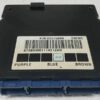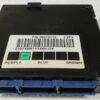Stop Chasing Electrical Gremlins in Your GM Truck
Are you tired of your 2001 Yukon, Tahoe, or Sierra acting possessed? Flickering lights, a security system that won’t cooperate, power windows with a mind of their own, or gauges that dance randomly are all classic signs of a failing Body Control Module (BCM). This module is the central nervous system for your truck’s body electronics, and when it starts to fail, it can cause a cascade of frustrating and unpredictable problems. Instead of spending a fortune at the dealership, get the reliable, plug-and-play solution you need right here.
This isn’t just a replacement part; it’s a complete solution. We take a high-quality BCM and pre-program it with the latest GM software updates, specifically matched to your vehicle’s VIN. This means you skip the expensive trip to the dealer for programming. It arrives at your door ready to be installed, getting you back on the road with confidence and restored functionality.
A Technician’s Notebook: The 2001 Sierra with a Ghost
I had a 2001 Sierra 1500 roll into my bay last month that had its owner completely stumped. The complaint was ‘it does weird stuff.’ The security light would flash, the radio would turn off, and the power door locks would cycle while driving. The owner had already replaced the battery and checked all the fuses. After connecting my scan tool, I saw a handful of U-codes (communication errors) pointing to a network issue. In these early 2000s GM trucks, this pattern almost always leads back to one culprit: the BCM. A failing BCM can’t properly manage the data bus, causing other modules to report errors. We installed a VIN-programmed BCM like this one, and every single ghost in his machine vanished. It’s a common failure I’ve seen hundreds of times, and a fresh, correctly programmed module is the definitive fix.
Is Your GM Truck Showing These Symptoms?
A faulty BCM can manifest in many ways. If you’re experiencing any of the following, it’s highly likely your 2001 Yukon BCM is the root cause:
- ✔ Erratic or non-functional interior/exterior lights
- ✔ Power windows, mirrors, or door locks not working correctly
- ✔ The security or anti-theft light stays on, preventing the truck from starting
- ✔ Gauges on the instrument cluster sweeping or not working
- ✔ The radio or other accessories turning on and off by themselves
- ✔ Diagnostic trouble codes (DTCs) related to communication errors (e.g., U1000) or body systems (B-codes).
Your Straightforward BCM Installation Guide
For the confident DIYer, replacing the BCM is a manageable job. It’s typically located under the driver’s side of the dashboard. Follow these general steps for a successful installation:
- Safety First: Always disconnect the negative terminal from your vehicle’s battery before starting any electrical work.
- Locate the BCM: On most 2001 GM trucks and SUVs, the BCM is mounted to the left of the steering column, often behind a lower dash panel.
- Disconnect and Remove: Carefully unplug the electrical connectors. They have locking tabs that need to be depressed. Once disconnected, unbolt or unclip the old BCM and remove it from the vehicle.
- Install the New Module: Mount your new, pre-programmed BCM in the same location and securely reconnect all the electrical connectors. You should hear a ‘click’ as they lock into place.
- Reconnect Power: Re-attach the negative battery terminal.
- Perform Final Checks: Turn the key to the ‘On’ position and test your lights, windows, locks, and other accessories to ensure they are functioning properly. Please see the notes below regarding potential post-installation procedures.
Important Post-Installation Information
Because this BCM is new to your vehicle’s network, a couple of simple relearn procedures may be necessary in some cases:
- Airbag System Sync: If your airbag warning light is on after installation, a professional scan tool is needed to perform the ‘Setup SDM Primary Key in BCM’ procedure. This syncs the new BCM with the airbag system. This is only required if the light appears.
- Brake Pedal Position Relearn: On some models, a brake pedal position sensor recalibration might be needed to ensure your brake lights and traction control system function as they should.
Disclaimer: Vehicle systems can vary. We always recommend consulting a factory service manual or a qualified professional if you are unsure about any step.
Verified Fitment for These 2001 GM Models
This module is a direct replacement for part numbers 09375899, 9392990, 09370249, and 19180223 and is guaranteed to fit the following 2001 models:
- ✔ Chevrolet Silverado 1500, 2500, & 3500
- ✔ Chevrolet Tahoe (4×2, ID 9392990)
- ✔ Chevrolet Suburban 1500 & 2500 (ID 9392990)
- ✔ GMC Sierra 1500, 2500, & 3500
- ✔ GMC Yukon (4×2, ID 9392990)
- ✔ GMC Yukon XL 1500 & 2500 (ID 9392990)
Frequently Asked Questions
Do I need to get this BCM programmed by a dealer?
No. The main benefit of our service is that we program the module to your vehicle’s VIN before we ship it. It arrives ready to install, saving you time and the high cost of dealer programming.
What is a VIN and where do I find it?
The VIN is your vehicle’s 17-digit Vehicle Identification Number. You can easily find it on the driver’s side of the dashboard (visible through the windshield), on your vehicle’s registration, or on your insurance card.
Is there a core charge? Do I have to send my old part back?
No, there is absolutely no core charge for this part. You can keep your old module.
What if my airbag light comes on after I install it?
This can happen occasionally. It means the new BCM needs to be electronically ‘introduced’ to the airbag module. A mechanic with a professional-grade scan tool can perform the ‘Setup SDM Primary Key in BCM’ procedure to sync the systems and turn off the light.
Will this fix my ‘Security’ light issue?
Yes, a flashing or solid security light that prevents the vehicle from starting is one of the most common symptoms of a failed BCM. This pre-programmed module is designed to resolve that issue.
What tools are needed for the installation?
Basic hand tools are typically all that’s required, such as a socket set and a trim removal tool to access the BCM under the dashboard. No special programming tools are needed for the initial installation.


